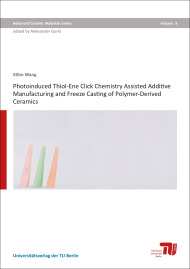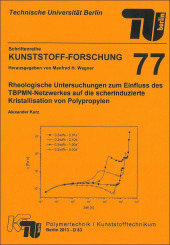Photoinduced thiol-ene click chemistry assisted additive manufacturing and freeze casting of polymer-derived ceramics

Format: 14,8 x 21,0 cm
Publishing year: 2019
Polymer-derived ceramics possess great advantages in the view of cellular ceramic processing compared to traditional powder-based technologies, as the polymeric nature of ceramic precursors allows the utilization of various shaping approaches. Amongst them, Additive Manufacturing and Freeze Casting are two novel shaping methods, which are capable of producing three-dimensional complex architectures and foams with well-controlled pore morphology, respectively.
In this thesis, photoinduced thiol-ene polymerization of vinyl containing preceramic polymers with thiol monomers is systematically investigated, both from the energetic view and from the kinetic view. Subsequently, a novel stereolithographic approach is developed and applied to the additive manufacturing of complex-shaped polymer-derived ceramics. In addition, photopolymerization-assisted freeze casting is successfully developed to freeze cast liquid preceramic polymer and yields porous ceramics with well-controlled pore morphology.
By utilizing the photoinduced thiol-ene polymerization, the developed stereolithographic approach is applied for the additive manufacturing of three classes of preceramic polymers, including polycarbosiloxane SPR212, polycarbosilane SMM10 and polycarbosilazane Durazane 1800. In the subsequent polymer-to-ceramic transformation, the additively-manufactured cellular polysiloxane and polysilazane successfully convert to SiOC and SiCN ceramics without major cracks, while the polycarbosilane SMP10 exploded into small pieces under the same pyrolyzing conditions due to high levels of hydrogenated groups in precursors. The additively-manufactured polysiloxane-derived SiOC components are nearly fully dense, achieving 97 % of the theoretical density and demonstrating excellent compressive strength, surpassing the performance of comparable porous ceramics and stretching the boundaries of material property space in terms of strength-to-weight ratio under compression.
The freeze casting technique assisted with cryo thiol-ene photopolymerization is developed successfully for the production of macroporous PDCs, demonstrating that the free radical-initiated thiol-ene click reaction effectively cross-linked the vinyl-containing liquid preceramic polymers into infusible thermosets even at low temperatures. The key factor of this approach relies on the complete photopolymerization of whole frozen samples. Therefore, a freezing liquid, preceramic polymers and fillers (e.g., SiO2) with weak absorption for UV light is preferred to allow high penetration depth, thus leading to the production of filled, solid samples. By utilizing GO suspension as the freezing liquid and applying the same procedure, unique ceramic shells of open cylindrical (tubular) shape with an axial hole were obtained. The post-pyrolysis HF acid treatments of produced SiOC monoliths yields hierarchical porosities, with SiOC/SiO2 nanocomposites after etching demonstrating the highest specific surface area of 494 m2/g and pore sizes across the macro-, meso- and micropores ranges.



